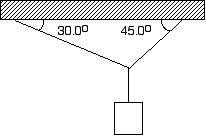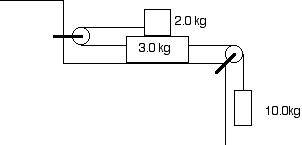
#1. A 50 kg crate slides across a horizontal surface at constant
speed when a horizontal force of 160 N is applied to it. What is the
coefficient of kinetic friction between the crate and surface?
#2. Find the tension in each wire if the weight of the suspended body
is 200.0 N.

#3. Two blocks are connected by a light string passing over a pulley. The inclined surfaces are fricitonless and the effects of the pulley can be ignored. If the values are mass m2=m1=1.00 kg, q1=46o, and q2 = 34o, what is the acceleration of the blocks?

#4. In the diagram below the coefficient of kinetic friction between
the two blocks is 0.30. The table surface and the pulleys are
frictionless. a) Determine the acceleration of each block. b) Find
the tensions in the strings.

#5. A highway curve with radius 900.0 ft is to be banked so that a car traveling 55.0 mph will not skid sideways even in the absence of friction.
a) Draw a free body diagram of the car and sum forces.
b) At what angle should the curve be banked?
#6. How much work is done by a force F = (2xN)i + (3N)j, with x in meters, that moves a particle from a position ri = (2m)i + (3m)j to a position rf = -(4m)i - (3m)j?
Answers:
1. .326
2. 200 N, 146 N, 179 N
3. .79 m/s2 to the left
4. 5.76 m/s2
5. 12.6o
6. -6J